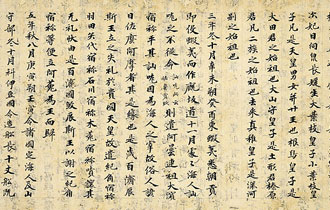Pages |
To a Westerner, accustomed to seeing religions being mutually exclusive, separate and competitive if not explicitly hostile, this may be comparable to a Catholic priest conducting the ritual for a Jewish bar mitzvah. However, to many Japanese the intermixture and interchangeability of Buddhist and Shintō aspects in their rituals and lives is normal, and they do not care whether a ritual to a Shintō deity is done in Buddhist or Shintō style. Moreover, they may not know, and certainly do not care, whether the patron deity of their community or the many other deities of relevance in their lives are Buddhist or Shinto. What does matter is that some ritual is performed for the deities and the ancestors. Ancestors and the various deities must receive their ritual attention, of one kind or the other. Without ritual attention the ancestors and deities may withhold protection or even punish the community and its people.
In spite of the interchangeability and intermixture of Buddhist and Shintō components in religious rituals, the Japanese do recognize the differences in the two traditions. Buddhism and Shintō have not become unified into a syncretic whole, but remain distinct. Children are still taught that in a Shintō ritual they should clap twice before bringing their hands together and bow when they address the deity and offer a prayer. In addressing their ancestors or Buddhist deities they do not clap but rather bring their hands together quietly and bow. The adults also know, and can recognize, the differences in Shintō prayers, norito, and Buddhist prayers or sutras, okyō, and the offerings that are provided at the altar. While both Shintō and Buddhist offerings include vegetables and fruits, the Shintō offerings typically add flesh food such as the colorful sea bream or red snapper. Flesh foods are not permitted in Buddhist offerings because of Buddhism's traditional prohibition against taking the life of any animal-a belief associated with reincarnation. With reincarnation, for example, it is possible that an animal that is sacrificed for an offering may in a previous life have been the ancestor of a neighbor or even one's own ancestor.
It should be noted, however, that the Hindu derived notion of reincarnation is not prominent in the version of Buddhism practiced by most Japanese today. In the past several decades the prohibition against eating flesh foods during mourning periods, particularly the first seven days after a death, or at periodic memorial services, has been greatly relaxed. It is not uncommon for family, relatives, and close neighbors and friends to leave the temple and cemetery after a funeral or memorial service and assemble at a hotel for a scrumptious banquet complete with all kinds of fish, both raw and cooked.
Shintō, "the way of the gods," is not a word heard very often in Japanese conversation. Rather, people talk about the deities or supernatural powers, kamisama, and the shrines, where such deities are worshiped. This reflects the fact that Shintō is not a unified, institutionalized religion with a central dogma. Rather, it is a collection of animistic beliefs and practices related to the world of the supernatural, both personified supernaturals (the deities, kami) and non-personified supernatural powers inherent in things and relationships. The term Shinto itself has a relatively recent history (i.e., relative to Japan's very ancient origins) and may go back only to the thirteenth century. It is a convenient term for scholars and intellectuals when discussing non-Buddhist religious things. However, most Japanese people in common discourse talk about the kamisama in general, or a particular deity, i.e., a specific kamisama, of relevance at that particular moment.
Pages |











